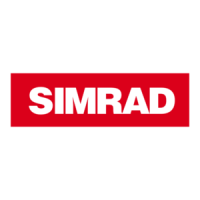For this reason, the transducer should to be mounted on a fairing block
which holds the transducer away from the hull and which directs the
flow of aerated water around the sides rather than over the face of the
transducer. On deep keeled vessels, care must be taken to ensure that the
transducer beam wil not be blocked by any part of the keel. Although the
appropriate mounting location depends on the type of vessel and its nor-
mal operating speeds, a practical choice is usually somewhere between
one third and one half of the vessel’s water line length from the bow.
Levelling blocks may be designed accordingly to meet this requirement.
F The more the transducer protrudes from the hull, the better the results
will be. Particularly the lower frequency operation, interference from pro-
peller noise can be a significant problem. This can be seen as an increase
in the ’noise’ on the echosounder display when the propeller speed is in-
creased. To help reduce this, the transducer’s mounting face may be an-
gled slightly forward on the order of 5° for the 50 kHz transducers and
3° for the 200 kHz transducers. The goal is to incline the transducer so
that a line of sight along the transducer’s radiating surface passes below
the propeller.
2323#OLOR4RACKPLOTTER
CE32 MKII NMEA RS2500 RS2800
0IN 4ERMINALSTRIP 0ORTTO
1 White TX A RD+1 0IN 5
2 Brown TX B RR+1 0IN 9
2323$IFFERENTIAL"EACON2ECEIVER
CE32 MKII NMEA RS5660/RS5665
0IN 3 Yellow RX A 0IN 2
0IN 4 Green RX B 0IN 5
%XTERNALPOSITIONHEADINGANDSPEED
CE32 MKII NMEA
0IN 3 Yellow RX A NMEA0183
0IN 4 Green RX B
/PTIONALCONNECTIONS
#HAPTER #%-+)))NSTALLATIONANDSERVICE
100

